What TrustRadius Research Says
Google Cloud SQL Pricing 2022
Enterprises need to store their data, whether it’s for personal information like addresses, performance reviews, contacts for clients and employees. Or for projects, or the creation of software and applications. They may need a database that connects all their related information together.
Databases like this are called relational databases and are generally coded with SQL. One major relational database service is offered by Google. Google Cloud SQL is their managed SQL database option so your business can save time by not focusing on upkeep.
Google Cloud Explained
Google Cloud is a cloud computing platform. Developers will primarily use this kind of service for storing, managing, and manipulating data. Google Cloud offers a number of other services that you can use like Compute Engine, Kubernetes, BigQuery, and Cloud SQL.
With all the products and services that Google Cloud offers you can create virtual machines, AI, Apps, an API, or an SQL relational database.
Google Cloud SQl is a managed database relational service that you can use with MySQL, PostgreSQL, and Microsoft’s SQL Server. MySQL, PostgreSQL, and SQL Server are all open source. This solution may be preferred, if you are an individual, small team, or startup. Compute time for Cloud SQL easily runs into the thousands.
The reason you would want to use Google Cloud SQL is so you don’t have to manage your database, and so you can also take advantage of Google Cloud’s many integrations. Using a managed SQL database is for the optimization of your business or project. By simplifying the upkeep of your database, you can work on other projects.
Below go over the intricacies of figuring out the cost of Google Cloud SQL. Their pricing model is not the most intuitive to follow, and many have found themselves with large bills they didn’t expect. That’s why it’s important to look at all the options in the estimate.
Google Cloud SQL Database Costs
Cloud SQL pricing is based on CPU and memory, storage and networking, and instances. Google Cloud SQL databases include MySQL, PostgreSQL, and SQL Server. The pricing for PostgreSQL and MySQL is the same, while SQL Server has its own pricing page.
It will help if you don’t see the rates provided as the actual end cost, they’re the amount charged against your runtime. You can take the number the Cloud SQL gives you, and do the math yourself but it could still very easily be a monthly bill you didn’t expect.
This is because there’s extra charges, and your rates change per region. It's recommended you use the pricing calculator, which we do in a later section, and contact their sales team. The pricing calculator gives you a ballpark idea but it's not guaranteed to be your actual bill, which is why confirming questions with sales is important.
Below we go into detail on the pricing rules and summarize some ranges. Then we take a look at the pricing calculator and mention some tips when you make your own estimate.
Google Cloud PostgreSQL and MySQL Pricing Specifics
For a PostgreSQLor MySQL database, you're allotted as much as 96 CPUs and 624 GB of memory. When taking a look at the costs for CPU and memory, before seeing the hourly and monthly rates you need to select your correct region.
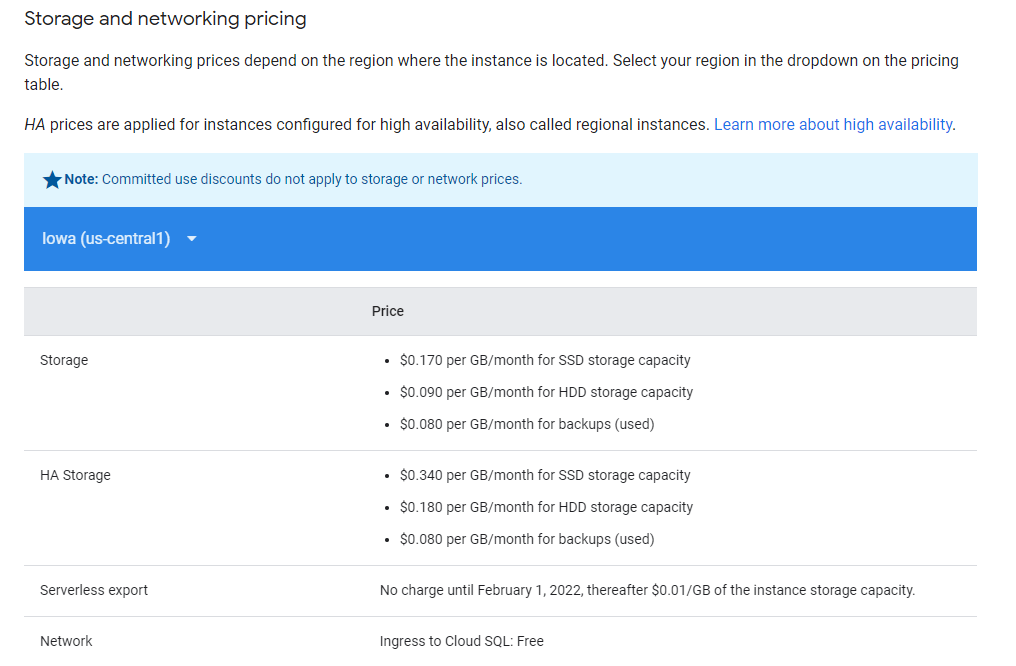
The default tends to be Iowa (us-central1), and is not useful if you don’t live in that region. The rates change pretty drastically depending on region so it may help to double check which central or eastern you would be. For example, my region is not central but it’s the closest option, so take your time deciding which region you are. If you have questions you can always contact their sales team.
The costs can be discounted for either a 1 year commitment or 3 year commitment. The rates (for Iowa us-central1), are generally 30.11 per vCPU and 5.11 per GB, for the monthly view of costs. Some of their not listed pricing, like read replicas or failover replicas are the same rate as stand-alone instances. For those that don’t USD as a currency, you can see their Cloud Platform SKUs for converting costs into your currency.
The memory and CPU cops with HA infront stand for high availability, aka regional instances. They cost more for the ability to reduce downtime that could be related to your zone or instance. Incase of power outages or corrupted instances, you will still have access. For more explanation of how they protect your data using failover see their page on high availability.
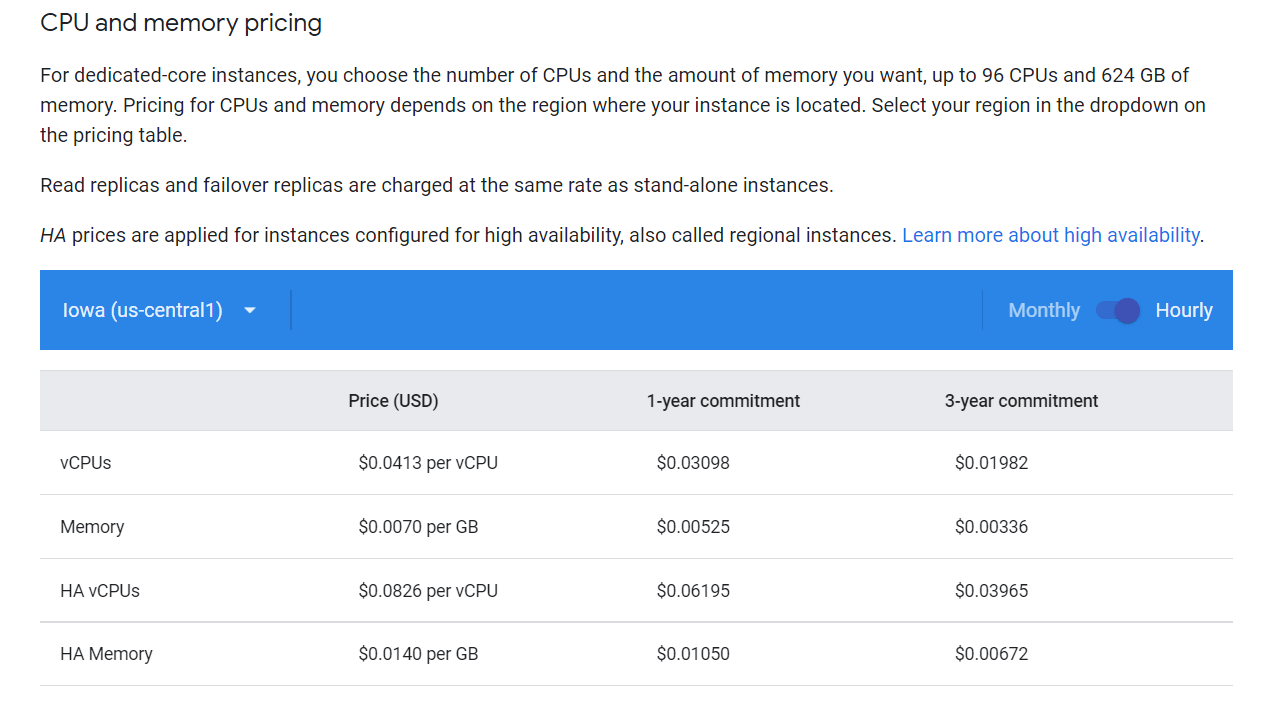
Storage and networking prices also are dependent on your region and have HA costs available as well. For regular storage, the rates are:
$0.170 per GB/month for SSD
$0.090 per GB/month for HDD
$0. 080 per GB, if you use any backups that month.
More charges related to network pricing include network egress pricing. Network egress is when network traffic leaves the Cloud SQL instance, to a Google product, or local server. There are extra costs for network egress, and you are priced differently depending on whether you transferred to a Google product or not. Region also incurs a charge as well. The general cost can be free, or as much as $0.19GB, all dependent on your chosen transfer destination.
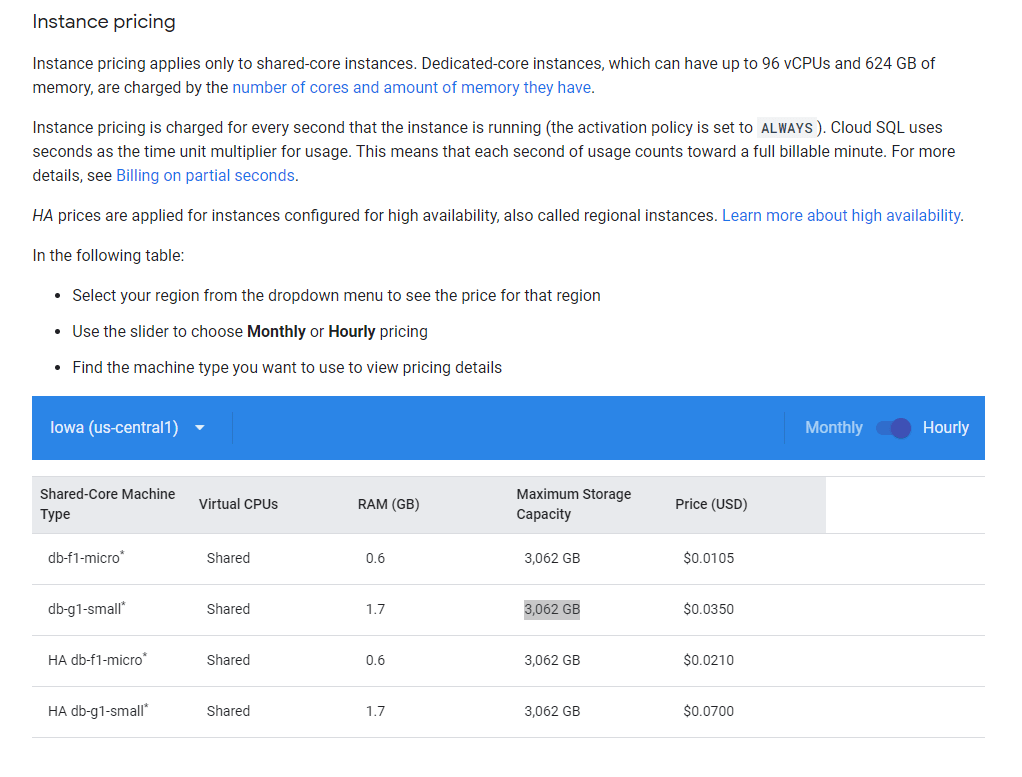
For instance pricing you are charged based on runtime for shared-core instances. You can look at the prices hourly or monthly, but the costs are charged per second. They have standard costs and HA prices as well.
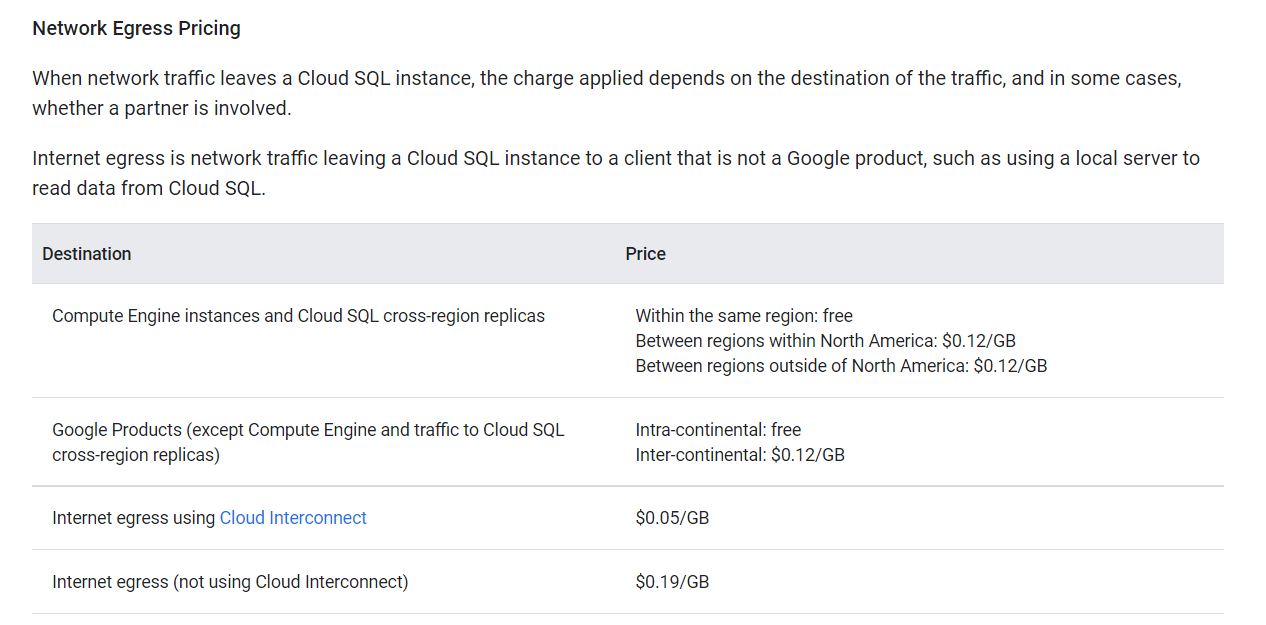
For the standard costs, it ranges from $0.0105 for 3,062 GB of storage, and $0.0350 for 3,062 GB storage. Again these are charged per second, and if you don’t make it to a full second there is partial second billing. For partial second billing, you start getting charged when you reach over 499 milliseconds. This means for 500ms/1.29s, you get billed for a full second.
Google Cloud SQL Server Pricing Specifics
Google Cloud SQl Server pricing is a little bit different from PostgreSQL and MySQL pricing. It’s based on CPU and memory, storage and networking, and licensing.
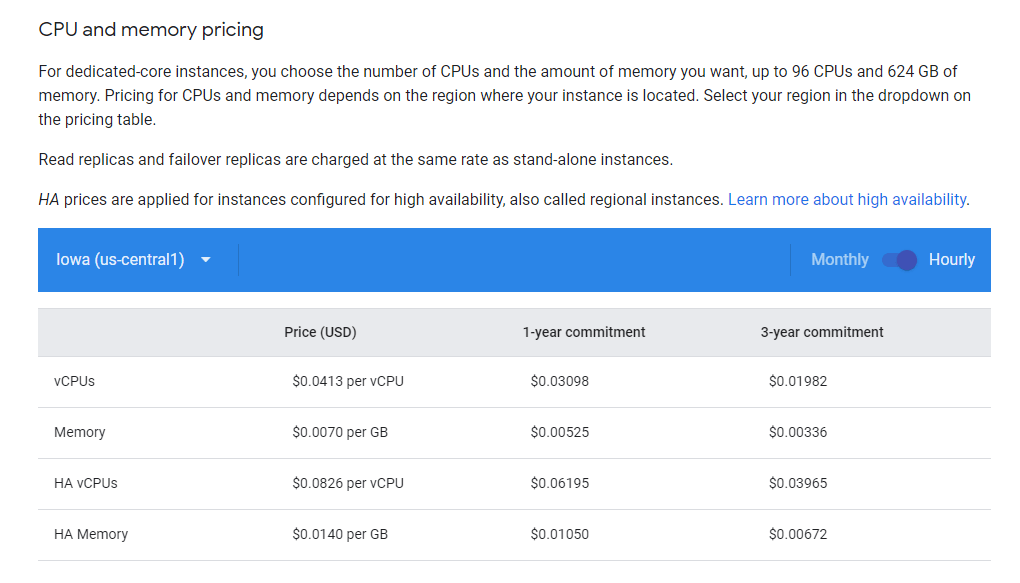
The pricing rules of CPU and memory for SQL Server are the same as PostgreSQL and MySQL. You can use up to 96 CPUs and 624 GB of memory, they have HA prices, failover and replicas are extra charges, and it’s based on dedicated-core instances. General costs are $0.0413 per vCPU and $0.0070 per GB of memory, and yearly commitments are notably less.
For storage and networking the pricing is also similar to the other relational databases Google Cloud SQL offers. The prices are per GB a month and offer HA pricing as well. The region again matters a lot on the rates as well.
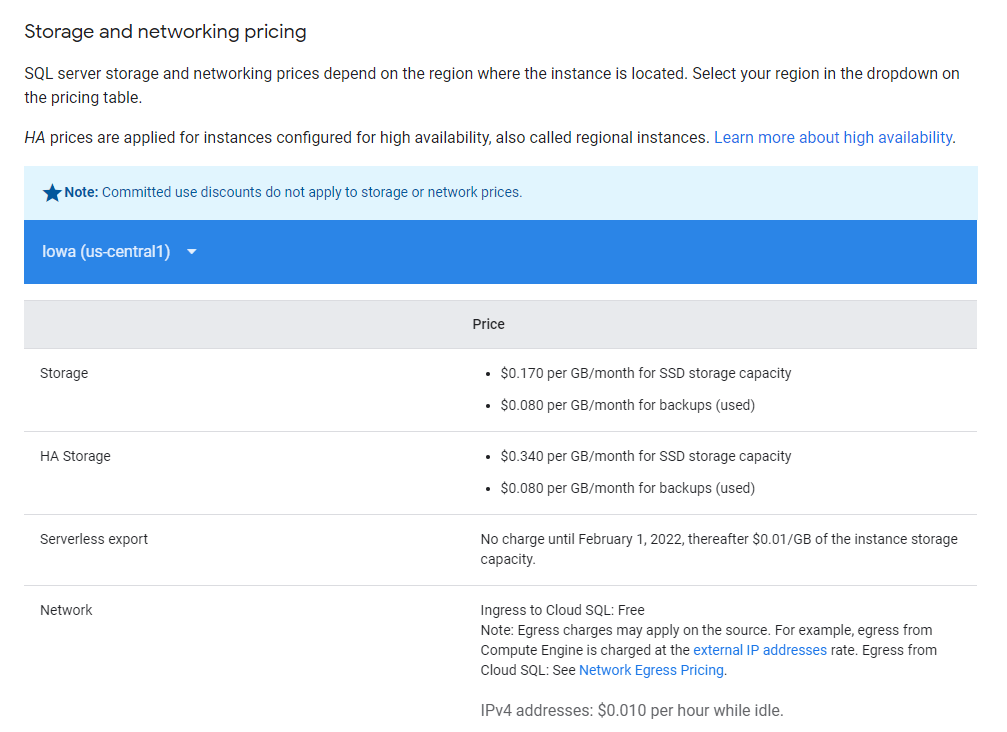
The cost for standard storage has less options than MySQL and PostgreSQL. They had the added option of HDD storage, but for SQL Server it's just SSD, and the rate for backups.
$0.170 per GB/month for SSD
$0.080 per GB/month for any backups you use
The network egress costs are set up the same way as the other databases, some charges are free, but transferring to non Google Cloud products is certainly not. The transfer rates are also the same. This means it’s free for Google products within the same continent and region, and $0.19/GB not within the same continent or region or to a Google product.
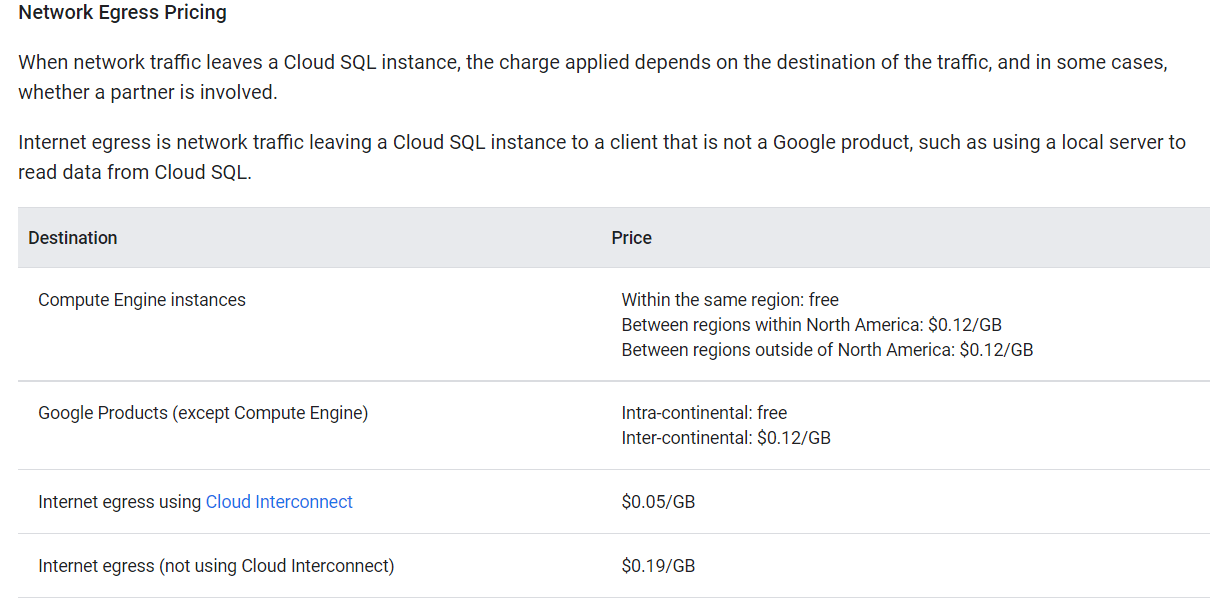
Then comes licensing, since SQL Server has a free edition but is still a Microsoft product. With licensing, you have to meet some minimum requirements. Your core license gets tied to each CPU of your instance, and it’s a 4 core requirement for each instance, even if you don’t use 4 vCPUs. If you use more 4 vCPUs or more, you’re charged the number of licenses equal your vCPUs.
The rates for SQL Server instances are also initially charged at a 10-minute minimum, and then 1-minute increments after the initial 10 minutes. The cost for editions of SQL Server are:
Microsoft SQL Server Enterprise is a rate of $0.47
Microsoft SQL Server Standard is a rate of $0.13
Microsoft SQL Server Web is a rate of $0.01134
Microsoft SQL Server Express is $0 (it’s the open-source version GCP accepts)
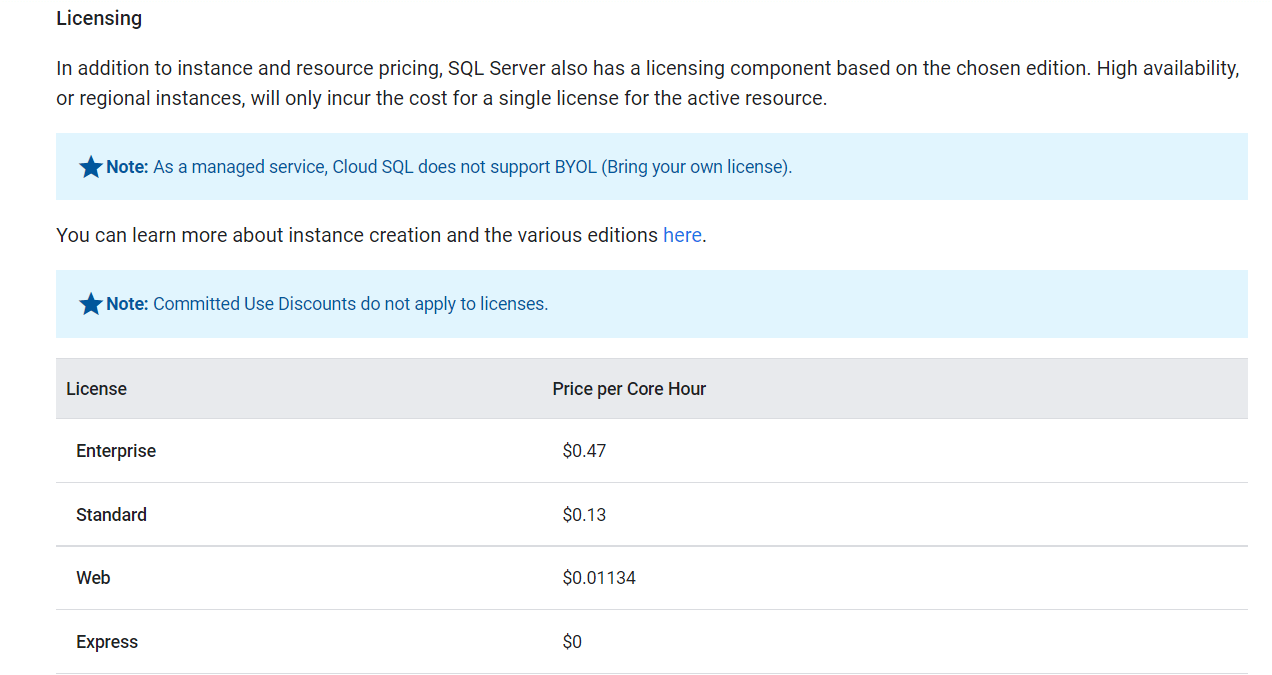
Below we look at creating an estimate with Google Cloud’s pricing calculator.
GCP: Google Cloud Pricing Calculator
Google Cloud’s pricing calculator has 4 sections that you can add to your estimate. These include instances, sole-tenant nodes, persistent disk, and Cloud TPUs.
For our look at the pricing, we only entered values for instances and nodes and kept defaults. This is because the number of instances and the number of nodes are required sections for you to fill out.
It’s meant to be as simple as possible to give you an idea of the costs. You will need to input your own unique specifications of your database or expected database. Even then, your estimate is only an estimate.
We have two estimates with slight differences below. By looking at them you can see some costs stay constant, like the default instance type (e2-standard-2) price.
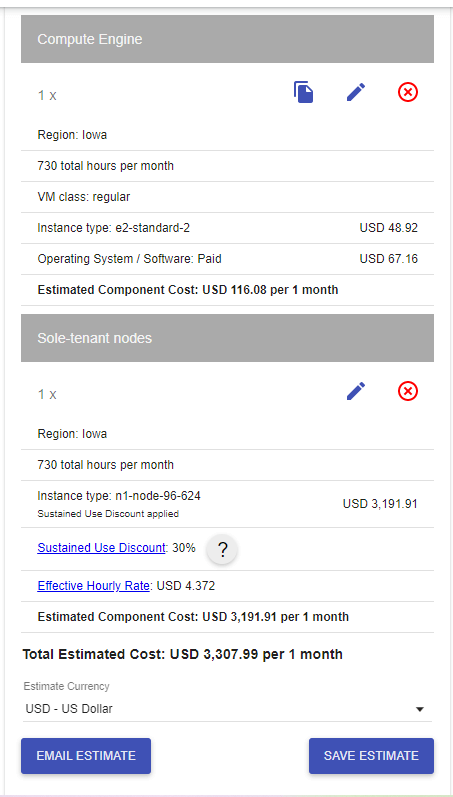
Now we went back and put in for the same estimate with 1 instance and 1 node. We got the same component cost but a different estimate. The difference was the software, if you don’t input anything the software will automatically be defaulted to free for the estimate. This is why it’s important to note all the individual options.
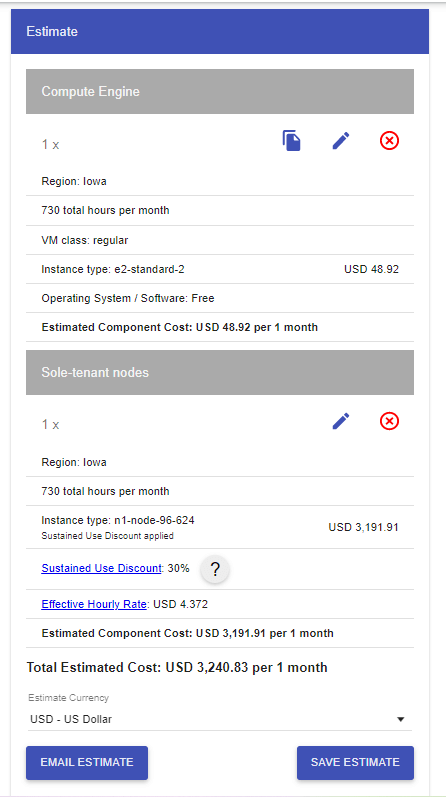
You can go here to create your own estimates, and if you have questions about how accurate your estimate is you can contact sales.
Google Cloud SQL vs AWS Aurora vs Microsoft Azure
The three giants for managed SQL databases include Google Cloud SQL, Microsoft Azure, and AWS Aurora. They all have very similar pricing models and offer pricing calculators. One may seem less than another, but the reality is the cost depends on your unique database. In general, all of them can go into the thousands per month for usage of your SQL database.
Each of these services is suitable for major companies and is meant to manage large quantities of data. All of them have auto-scaling, multiple applications within their cloud, and are compatible with either MySQL, PostgreSQL, or SQL Server.
Microsoft Azure has compatibility with SQL Server, which is their own SQL service, along with PostgreSQL, and MySQL. AWS Aurora offers MySQL, and PostgreSQL. Google Cloud SQL is compatible with SQL Server, PostgreSQL, and MySQL.
All of them offer a NoSQL service for non-relational databases as well. Microsoft Azure offers Cosmos DB, AWS has DynamoDB, and Google Cloud SQL also offers both Datastore and Bigtable.
If you need the most options for organizing and accessing your data in several formats and database structures, Google is your best bet. If you really prefer SQL Server, the company that created it is probably best, so Azure is your better choice. Amazon RDS does offer DB engine options for SQL Server, but not with Aurora.
Then again, it may not be just the right database structure you want. The other applications offered may be the deciding factor for you.
Microsoft Azure also has AI, machine learning, analytics, and developer tools. They have quite a few free services as well (that stay free after the first free 12 months of your account). These services include Visual Studio Code, Machine Learning, and DevTest Labs.
AWS comes with a vast range of applications from machine learning, robotics, and business services. When you create or switch your database to Aurora you can access a number of services to benefit your code, company, and team.
Google Cloud comes with a number of applications for optimizing your projects and data. The options are fairly diverse with data warehouses and libraries to API management, and with an array of developer tools available.
All three giants in development and data are great options to store and manipulate your relational database. One issue for some lower-budget teams is the cost of these giants. In the next section, we give a quick mention of the open-source SQL databases.
Most of these databases will require you manually manage them, so they are not the ideal option if saving time and effort is a major priority. Fortunately, some of these alternatives do offer a managed version (but not guaranteed to be completely open-source).
Open Source SQL Online Databases
For those that aren’t familiar with the open-source options for SQL databases here we go over a list of the most common ones readily available. Some of these services will include a managed version and NoSQL options.
MySQL Databases
PostgreSQL Databases
SQL Server Databases
MariaDB Server Databases
MySQL may be the most popular and easy-to-learn database system. MySQL Community Edition is open source and ready for download. It’s compatible with NoSQL, meaning you can combine your non relational and relational data in the same place.
There’s also MySQL Enterprise Edition, which is a managed database with security, backup, encryption, and integrations. Enterprise Edition is not open for download and requires an Oracle account.
PostgreSQL is an open-source option ready for download. There most recent versions include 14.1, and 13.5. Their two new releases have heightened security and are highly recommended.
Microsoft SQL Server offers downloads for their free, open-source versions, SQL Server 2019 Developer, and SQL Server Express are the most current ones. You can also sign up for a Microsoft account and use SQL Server on the cloud.
MariaDB is from the creators of MySQL. You can see the common theme with the dolphin for MySQL, and seal for MariaDB. They have multiple downloads from as recent as November 2021. The new versions have advanced clustering and can be integrated with Oracle like MySQL.
For more information and resources see the next section. At the end of the article, we also provide a key terms list as well.
More Resources
You may want to see more relational database options, we have a great list of alternatives for Google Cloud SQL. If you want a better look at using Google Cloud SQL in action, we have a tutorial for setting up your MySQL database.
Please also consider leaving a review to help other buyers make informed decisions.
GCP SQL Key Term Breakdown
Some of the terms and concepts you will see while shopping for a good relational database software might be new or require some review. Here we keep all the undefined phrases from the article, and extra explanations to give a good background to SQL databases while you shop around.
SQL or Secure Query Language
SQL stands for Secure Query Language (SQL can be pronounced ‘Sequel’). It is a programming language for relational databases. With a relational database, you often connect specific parts of data to their related categories and information.
This can be for an employee who needs to be connected to their address information, hiring information, and performance review. It can also be for a client that you need to connect to their address, their company and company address, their specific client information, and any other categories they belong in.
You can then use those tables of information to research your own data or to pull the information you need to use. Using queries, you can take data from the tables of information, so you can have a custom view to organize your information.
You can use a query to create a mailing list of companies you worked within the past year so you can send out a newsletter to advertise some deals and changes to bring them back in. Relational databases make it easier to access the companies, the dates, and the addresses for the query. SQL is simply the language used to ask or query, your database for the things you want.
There are database systems that let you do this without learning SQL. Microsoft Access works the same way but it comes with a UI that lets you drag and drop instead of coding. If you are a small business this may be your ideal solution, but Microsoft Access is far too small for major projects or the personal data of large companies.
NoSQL or Non-SQL or Non-relational Database
NoSQL is a newer coding language and is for non-relational databases. This could be storing information that you do not need to connect to several other categories. It could also be because you want to access the data in a different manner. NoSQL can be faster while handling large amounts of data, but without being impeded by complex structures found in SQL.
This does not automatically mean you can use a NoSQL database or SQL interchangeably. Not all information can easily be switched back and forth, because what you want in a relational database may not work in a NoSQL database.
When you can, however, switch to NoSQL, it might be the better decision to access, analyze and use your data faster. Sometimes, NoSQL databases are cheaper, but not always. Even better, is in the cases where you can combine NoSQL data and SQL data in the same database so you can have both. MySQL has open-source versions that offer this capability.
GCP offers Datastore and Bigtable as NoSQL database options.
Application Programming Interface (API)
Application Programming Interface is an interface connecting programs or computer programs. They’re used as an interface to perform services for other systems. API’s instruct the system what to do, so it can function properly for you. APIs you may know of include Google Maps, Twitter, and Instant Message systems. Programming languages that can use APIs include Javascript, Java, Ruby, PHP, and many more.
CPU Central Processing Unit
A CPU is often called the central or main processor because it handles control, logic, and I/O operations. It’s where instructions are taken and executed. When referred to with storage it means the primary storage.
GB Gigabyte
A gigabyte is a common unit of measurement for types of data storage.
VMs Virtual Machines
Virtual machines are a simulation on a computer that lets you experience and test different operating systems or devices. This way applications can be designed for Mac and Windows, mobile apps for iOS and Android, and games for both Xbox and Playstation.
Open Source / Open-source (hyphen is not required)
Open-source usually refers to software that is free to download, use, or study on the internet. The developer will make their license for the specific version that is free, open to be manipulated, used, distributed by anyone.
The reason someone would choose to not have a capital gain is because they want more developers to learn and create in collaboration. That and many of the tech giants have a paid version of the software that is easier for businesses to use or is more efficient in some way.
For example, Microsoft has Azure for managing SQL Server but has an open-source edition of SQL Server from 2019. This way tech giants can foster goodwill and help developers, who may end up working for them, grow and learn. While also making money off the same software at the same time.
Instance
The definition for an instance with SQL databases can change depending on the software and service you use. In broad terms, the instance is the memory needed to pull your data. It also includes the software which changes depending on the service.
DB Engine or Database Engine
A DB engine is the database management system DBMS, that you use to create and interact with your data. Your DB engine can be MySQL, PostgreSQL, MariaDB etc.
I/O Input/Output, Throughput, Latency
I/O means the input/output. This is expressed in IOPS, which is the amount of I/O per second. Latency is the duration between your request and when it’s actually done. You can think of it as similar to loading time.
Throughput can mean a couple of different things, the rate of production, the speed that your data takes to travel, capacity. For storage, when they talk about throughput they generally mean read/write throughput, which considers both capacity and latency and I/O. It is the amount of data transferred to the disk each second. You can measure throughput in megabytes per second MB/s.








